Synthesis of Carbon Nanotube Arrays with High Aspect Ratio via Ni-Catalyzed Pyrolysis of Waste Polyethylene
Abstract
:1. Introduction
2. Experimental
2.1. Materials and Preparation
2.2. Characterization
2.3. Measurement of Adsorption Capacity
3. Results and Discussion
3.1. Effects of Pyrolysis Temperature on the Preparation of Carbon Nanotubes from Waste Polyethylene
3.2. Effect of Ni Concentration on the Preparation of CNTs from Waste Polyethylene
3.3. Transmission Electron Microscopy and High-Resolution Transmission Electron Microscopy Characterization
3.4. Adsorption Capacity of Samples
4. Conclusions
Author Contributions
Funding
Conflicts of Interest
References
- Wang, D.W.; Li, F.; Liu, M. 3D aperiodic hierarchical porous graphitic carbon material for high-rate electrochemical capacitive energy storage. Angew. Chem. 2010, 121, 1553. [Google Scholar] [CrossRef]
- Park, S.; Vosguerichian, M.; Bao, Z. A review of fabrication and applications of carbon nanotube film-based flexible electronics. Nanoscale 2013, 5, 1727–1752. [Google Scholar] [CrossRef] [PubMed]
- Avouris, P.; Freitag, M.; Perebeinos, V. Carbon-nanotube photonics and optoelectronics. Nat. Photonics. 2008, 2, 341–350. [Google Scholar] [CrossRef]
- Grace, T.; Yu, L.; Gibson, C. Investigating the effect of carbon nanotube diameter and wall number in carbon nanotube/silicon heterojunction colar cells. Nanomaterials 2016, 6, 52. [Google Scholar] [CrossRef] [PubMed]
- Al-Saleh, M.H.; Sundararaj, U. A review of vapor grown carbon nanofiber/polymer conductive composites. Carbon 2009, 47, 2–22. [Google Scholar] [CrossRef]
- Iijima, S. Helical microtubules of graphitic carbon. Nature 1991, 354, 56–58. [Google Scholar] [CrossRef]
- Guo, T.; Nikolaev, P.; Thess, A.; Colbert, D.T.; Smalley, R.E. Catalytic growth of single-walled manotubes by laser vaporization. Chem. Phys. Lett. 1995, 243, 49–54. [Google Scholar] [CrossRef]
- Lim, S.Y.; Norani, M.M. The Effect of Catalyst on Carbon Nanotubes (CNTs) Synthesized by Catalytic Chemical Vapor Deposition (CVD) Technique. Adv. Mater. Res. 2011, 364, 232–237. [Google Scholar] [CrossRef]
- Li, T.X.; Kuwana, K.; Saito, K.; Zhang, H.; Chen, Z. Temperature and carbon source effects on methane–air flame synthesis of CNTs. Proc. Combust. Inst. 2009, 32, 1855–1861. [Google Scholar] [CrossRef]
- And, C.H.S.; Harris, A.T. A review of carbon nanotube synthesis via fluidized-bed chemical vapor deposition. Ind. Eng. Chem. Res. 2007, 46, 997–1012. [Google Scholar]
- Guo, Y.H.; Ding, K.X.; Jiang, P.; Sun, B.M. Experimental comparative study of carbon nanotubes synthesized from CO and CH4 by flame pyrolysis method. Appl. Mech. Mater. 2015, 751, 55–60. [Google Scholar] [CrossRef]
- Lu, H.B.; Boulos, R.A.; Chan, B.C. Carbon nanofibres from fructose using a light-driven high-temperature spinning disc processor. Chem. Commun. 2014, 50, 1478–1480. [Google Scholar] [CrossRef] [PubMed]
- Kong, Q.; Zhang, J. Synthesis of straight and helical carbon nanotubes from catalytic pyrolysis of polyethylene. Polym. Degrad. Stab. 2007, 92, 2005–2010. [Google Scholar] [CrossRef]
- Jiang, Z.; Song, R.; Bi, W.; Lu, J.; Tang, T. Polypropylene as a carbon source for the synthesis of multi-walled carbon nanotubes via catalytic combustion. Carbon 2007, 45, 449–458. [Google Scholar] [CrossRef]
- Zhang, J.; Du, J.; Qian, Y.; Xiong, S. Synthesis, characterization and properties of carbon nanotubes microspheres from pyrolysis of polypropylene and maleated polypropylene. Mater. Res. Bull. 2010, 45, 15–20. [Google Scholar] [CrossRef]
- Yen, Y.W.; Huang, M.D.; Lin, F.J. Synthesize carbon nanotubes by a novel method using chemical vapor deposition-fluidized bed reactor from solid-stated polymers. Diam. Relat. Mater. 2008, 17, 67–570. [Google Scholar] [CrossRef]
- Napolskii, K.S.; Eliseev, A.A.; Yesin, N.V. Ordered arrays of Ni magnetic nanowires: Synthesis and investigation. Phys. E 2007, 37, 178–183. [Google Scholar] [CrossRef]
- Di, J.T.; Yong, Z.Z.; Yang, X.J.; Li, Q.W. Structural and morphological dependence of carbon nanotube arrays on catalyst aggregation. Appl. Surf. Sci. 2011, 258, 13–18. [Google Scholar] [CrossRef]
- Zhang, H.; Haba, M.; Okumura, M.; Akita, T.; Hashimoto, S.; Toshima, N. Novel formation of Ag/Au bimetallic nanoparticles by physical mixture of monometallic nanoparticles in dispersions and their application to catalysts for aerobic glucose oxidation. Langmuir 2013, 29, 10330–10339. [Google Scholar] [CrossRef] [PubMed]
- Zhang, H.; Okuni, J.; Toshima, N. One-pot synthesis of Ag-Au bimetallic nanoparticles with Au shell and their high catalytic activity for aerobic glucose oxidation. J. Colloid Interface Sci. 2011, 354, 131–138. [Google Scholar] [CrossRef] [PubMed]
- Wu, C.; Nahil, M.A.; Miskolczi, N.; Huang, J.; Williams, P.T. Processing real-world waste plastics by pyrolysis-reforming for hydrogen and high-value carbon nanotubes. Environ. Sci. Technol. 2014, 48, 819–826. [Google Scholar] [CrossRef] [PubMed]
- Song, R.; Ji, Q. Synthesis of Carbon Nanotubes from Polypropylene in the Presence of Ni/Mo/MgO Catalysts via Combustion. Chem. Lett. 2011, 40, 1110–1112. [Google Scholar] [CrossRef]
- Pawlyta, M.; Rouzaud, J.N.; Duber, S. Raman microspectroscopy characterization of carbon blacks: Spectral analysis and structural information. Carbon 2015, 84, 479–490. [Google Scholar] [CrossRef]
- Dresselhaus, M.S.; Dresselhaus, G.; Saito, R. Raman spectroscopy of carbon nanotubes. Phys. Rep. 2005, 409, 47–99. [Google Scholar] [CrossRef]
- Kumar, M.; Ando, Y. Chemical Vapor Deposition of Carbon Nanotubes: A Review on Growth Mechanism and Mass Production. J. Nanosci. Nanotechnol. 2010, 10, 3739–3758. [Google Scholar] [CrossRef] [PubMed] [Green Version]
- Gong, J.; Liu, J.; Jiang, Z.; Wen, X.; Chen, X.; Mijowska, E.; Wang, Y.; Tang, T. Effect of the added amount of organically-modified montmorillonite on the catalytic carbonization of polypropylene into cup-stacked carbon nanotubes. Chem. Eng. J. 2013, 225, 798–808. [Google Scholar] [CrossRef]
- Gong, J.; Liu, J.; Chen, X.; Jiang, Z.; Wen, X.; Mijowska, E.; Tang, T. Striking influence of NiO catalyst diameter on the carbonization of polypropylene into carbon nanomaterials and their high performance in the adsorption of oils. RSC Adv. 2014, 4, 33806–33814. [Google Scholar] [CrossRef]
- Gong, J.; Liu, J.; Jiang, Z.; Feng, J.; Chen, X.; Wang, L.; Mijowska, E.; Wen, X.; Tang, T. Striking influence of chain structure of polyethylene on the formation of cup-stacked carbon nanotubes/carbon nanofibers under the combined catalysis of CuBr and NiO. Appl. Catal. B Environ. 2014, 147, 592–601. [Google Scholar] [CrossRef]
- Sharuddin, S.D.; Abnisa, F.; Wan Daud, W.M.A.; Aroua, M.K. A review on pyrolysis of plastic wastes. Energy Converse Manag. 2016, 115, 308–326. [Google Scholar] [CrossRef]
- Wang, J.; Deng, X.; Zhang, H.; Zhang, Y.; Duan, H.; Lu, L.; Song, J.; Tian, L.; Song, S.; Zhang, S. Synthesis of carbon nanotubes via Fe-catalyzed pyrolysis of phenolic resin. Phys. E 2017, 86, 24–35. [Google Scholar] [CrossRef]
- Song, J.; Zhang, H.; Wang, J.; Huang, L.; Zhang, S. High-yield production of large aspect ratio carbon nanotubes via catalytic pyrolysis of cheap coal tar pitch. Carbon 2018, 130, 701–713. [Google Scholar] [CrossRef]
- Gong, J.; Liu, J.; Ma, L. Effect of Cl/Ni molar ratio on the catalytic conversion of polypropylene into Cu–Ni/C composites and their application in catalyzing “Click” reaction. Appl. Catal. B Environ. 2012, 117–118, 185–193. [Google Scholar] [CrossRef]
- Gong, J.; Feng, J.; Liu, J. Catalytic carbonization of polypropylene into cup-stacked carbon nanotubes with high performances in adsorption of heavy metallic ions and organic dyes. Chem. Eng. J. 2014, 248, 27–40. [Google Scholar] [CrossRef]
- Rashid, M.H.; Ralph, S.F. Carbon Nanotube Membranes: Synthesis, Properties, and Future Filtration Applications. Nanomaterials 2017, 7, 99. [Google Scholar] [CrossRef] [PubMed]
- Shang, J.J.; Yang, Q.S.; Yan, X.H. Ionic adsorption and desorption of CNT nanoropes. Nanomaterials 2016, 6, 177. [Google Scholar] [CrossRef] [PubMed]
- Islam, M.A.; Ahmed, M.J.; Khanday, W.A.; Asif, M.; Hameed, B.H. Mesoporous activated carbon prepared from NaOH activation of rattan (Lacosperma secundiflorum) hydrochar for methylene blue removal. Ecotoxcol. Environ. Saf. 2017, 138, 279–285. [Google Scholar] [CrossRef] [PubMed]
- Feng, J.; Gong, J.; Wen, X. Upcycle waste plastics to magnetic carbon materials for dye adsorption from polluted water. RSC Adv. 2014, 4, 26817–26823. [Google Scholar] [CrossRef]
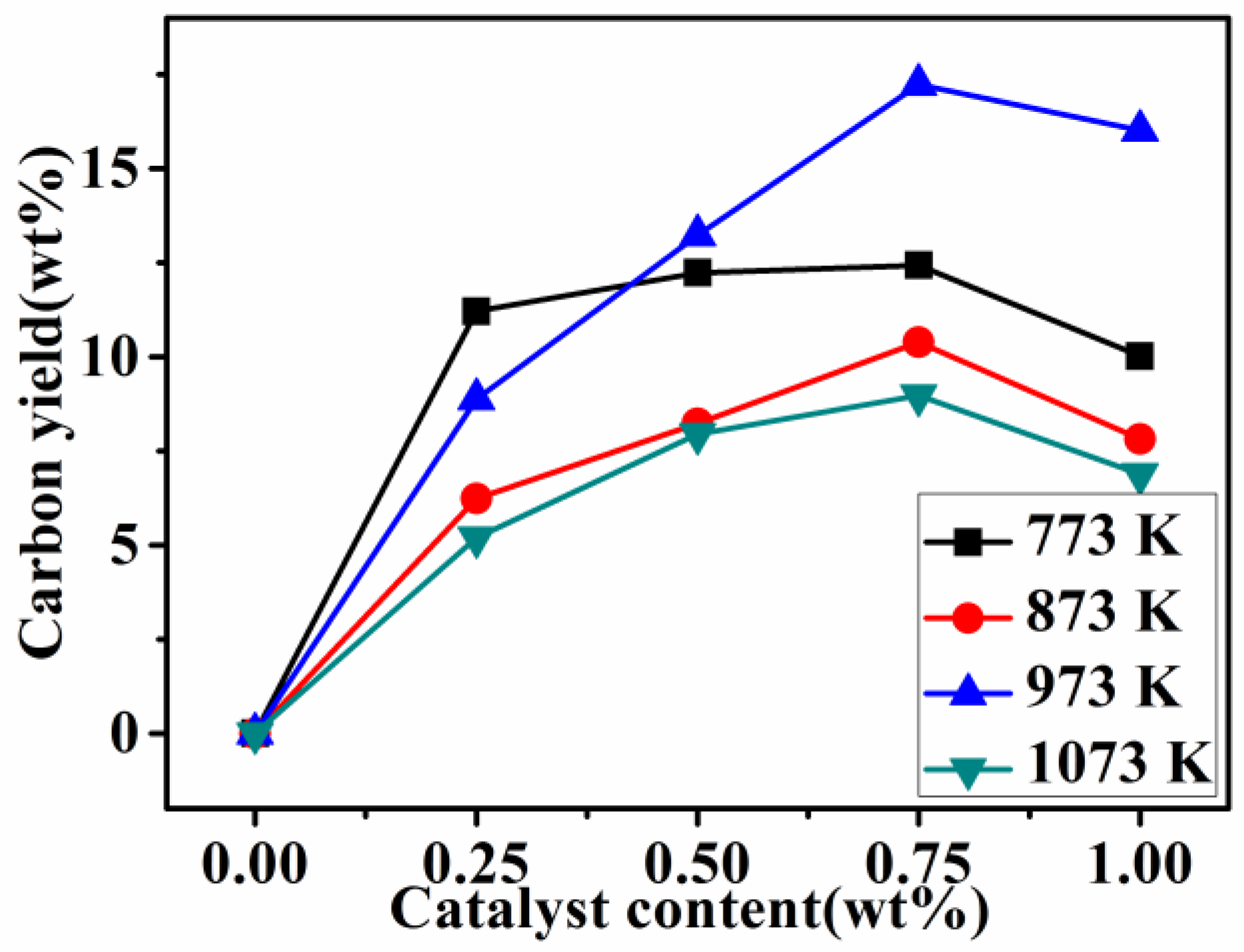
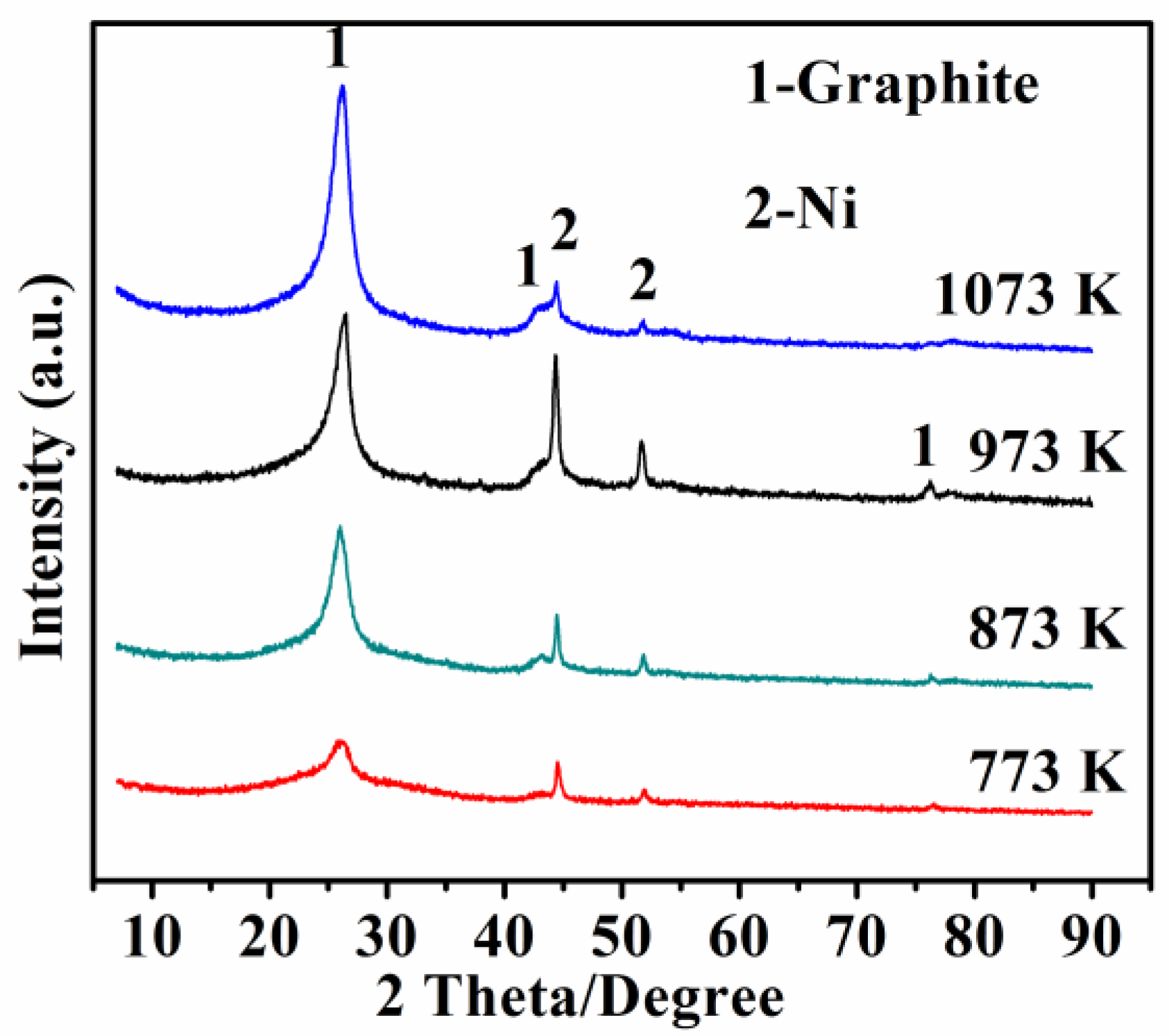


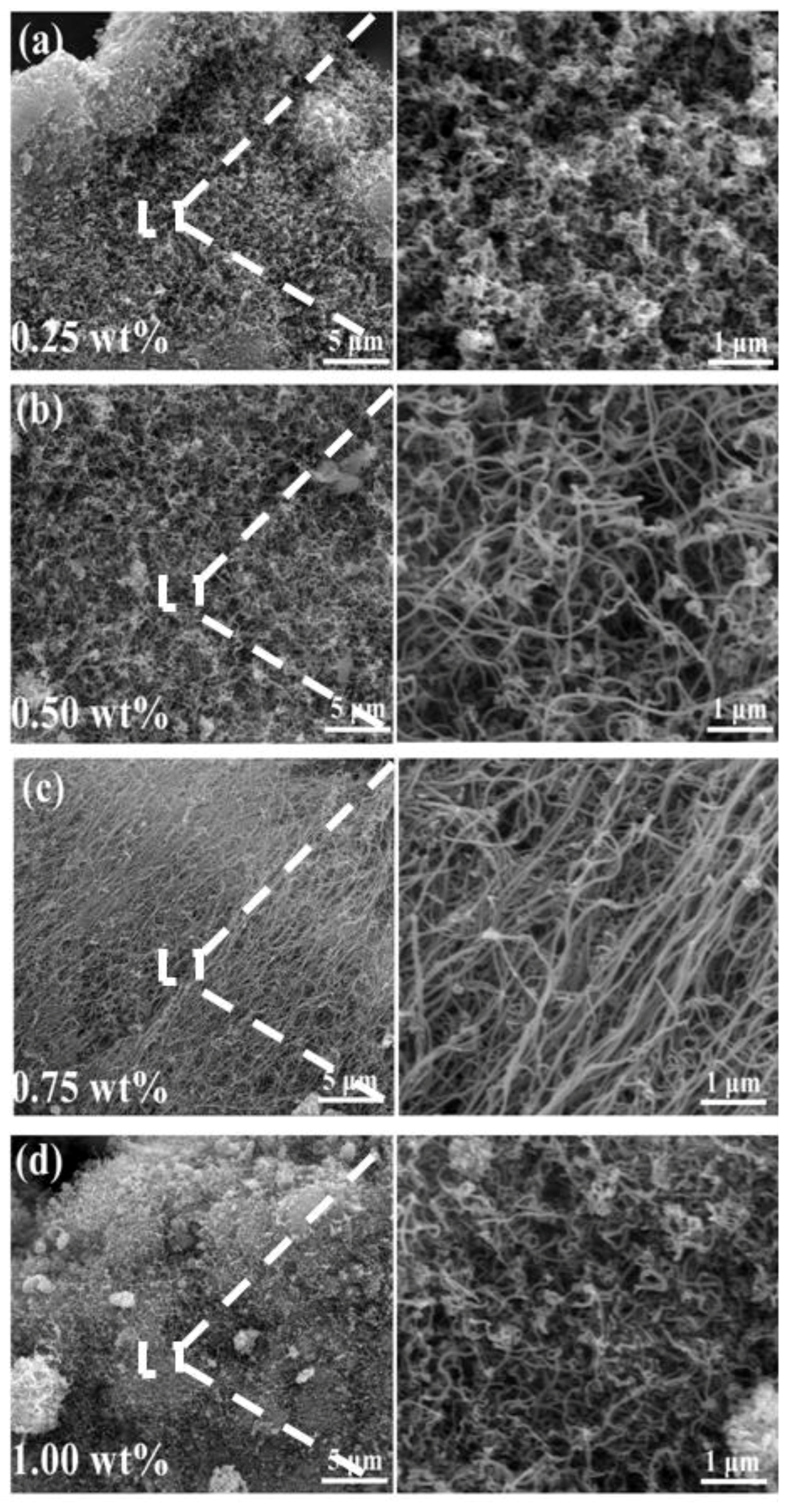


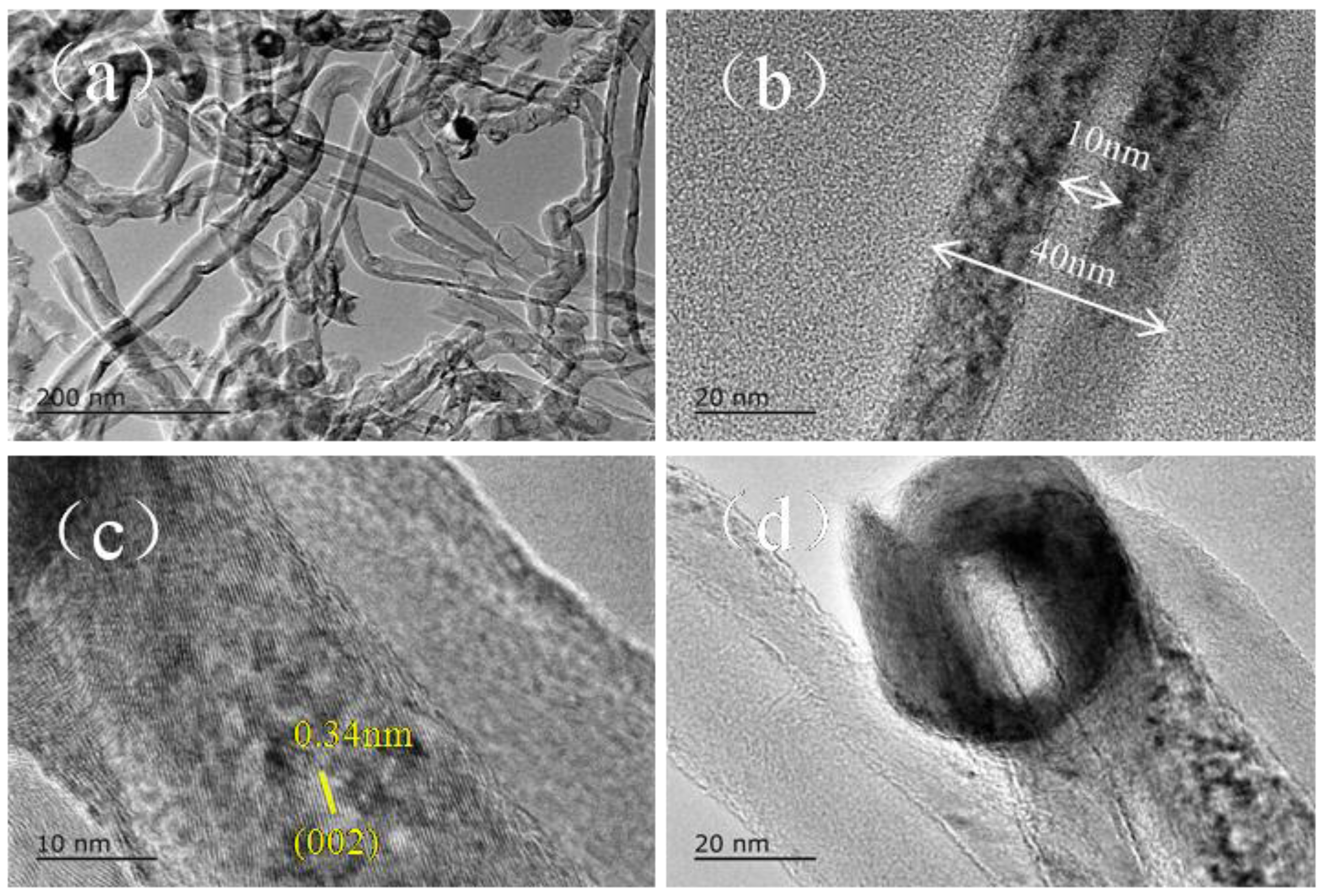
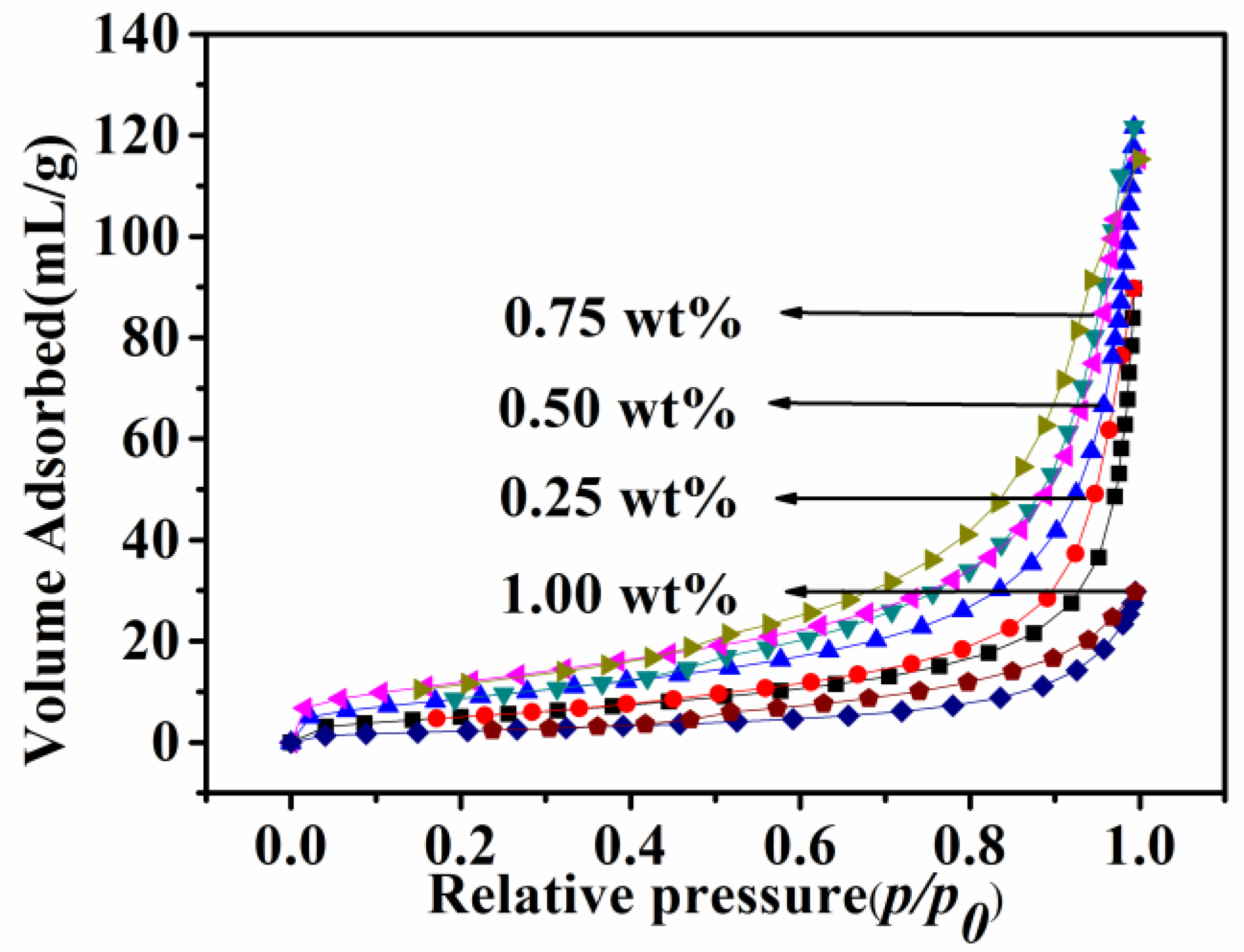


| Langmuir | Freundich | Pseudo-First-Order | Pseudo-Second-Order | ||||||||
|---|---|---|---|---|---|---|---|---|---|---|---|
| Q0 | b | R2 | kF | n | R2 | qe | k1 | R2 | qe | k2 | R2 |
| 33.10 | 0.068 | 0.961 | 1.056 | 1.26 | 0.984 | 15.6 | 0.41 | 0.987 | 16.5 | 0.1433 | 0.999 |
© 2018 by the authors. Licensee MDPI, Basel, Switzerland. This article is an open access article distributed under the terms and conditions of the Creative Commons Attribution (CC BY) license (http://creativecommons.org/licenses/by/4.0/).
Share and Cite
Zheng, Y.; Zhang, H.; Ge, S.; Song, J.; Wang, J.; Zhang, S. Synthesis of Carbon Nanotube Arrays with High Aspect Ratio via Ni-Catalyzed Pyrolysis of Waste Polyethylene. Nanomaterials 2018, 8, 556. https://doi.org/10.3390/nano8070556
Zheng Y, Zhang H, Ge S, Song J, Wang J, Zhang S. Synthesis of Carbon Nanotube Arrays with High Aspect Ratio via Ni-Catalyzed Pyrolysis of Waste Polyethylene. Nanomaterials. 2018; 8(7):556. https://doi.org/10.3390/nano8070556
Chicago/Turabian StyleZheng, Yangfan, Haijun Zhang, Shengtao Ge, Jianbo Song, Junkai Wang, and Shaowei Zhang. 2018. "Synthesis of Carbon Nanotube Arrays with High Aspect Ratio via Ni-Catalyzed Pyrolysis of Waste Polyethylene" Nanomaterials 8, no. 7: 556. https://doi.org/10.3390/nano8070556






